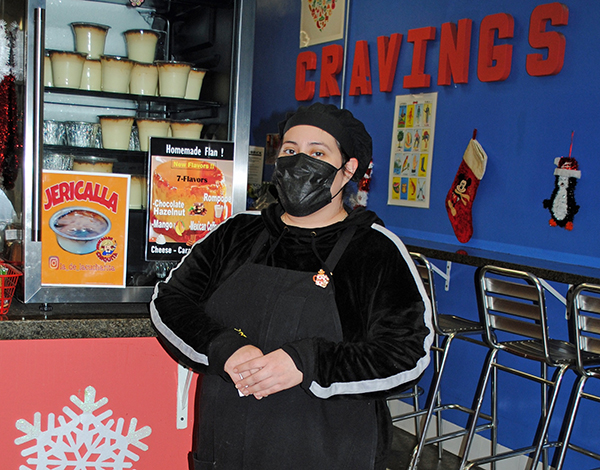By Alfredo Santana
Contributing Writer
SOUTH GATE — Limited purchases of food containers combined with supply chain snags and rising costs of products have forced Leslie Romo and her aunt Ana to rise prices at Cravings restaurant.
A freshly made ham or turkey sandwich sold for less than $10 a year ago. Now it costs $12, causing some customers to grab less expensive items, or walking out the door and going somewhere else.
“We have customers who ask how much are the dishes, and a few say no, turn around and go,” Romo said. “Fortunately, most of our diners are willing to pay the increases. The cost of meats have gone up in the last months, and we had to pass that on to the customers.”
When most businesses reopened to let customers shop and dine indoors without major COVID-19 restrictions last June 15, some business operators feared that understaffed outlets, upward pressures to increase wages for new workers and shortages of production from global supplies would hit them soon.
Now Romo runs out of beverages like Snapple, Mexican sodas and Coke in plastic bottles almost every week.
With an average of 40 customers a day paired with a seasonal decline in sales of concocted fruit blends, Romo, who is the assistant manager at Cravings, struggles to replenish supplies due to a combination of disruptions in deliveries caused by the pandemic, and a lack of drivers to do the job.
Facing additional uncertainty with the rapidly transmissible Omicron variant already making customers shelter at home to fend off transmissions, Romo’s small business and thousands more of similar size are less able to deal with supply snafus coupled with 6.8% inflation gauged in November by the U.S. Bureau of Labor Statistics and reported in the Consumer Price Index.
Rising inflation in the last 12 months is the largest jump in 40 years.
Federal Reserve Chairman Jerome Powell announced Dec. 15 that the central bank plans to raise interest rates three times in 2022 to control high inflation, and to accelerate plans to stop purchasing bonds that strengthened the economy during the pandemic.
Powell admitted to Congress that inflation is no longer transitory.
Complaints about high inflation started showing up last spring, affecting prices of gasoline in Los Angeles County that surged to $5 per gallon and to avocadoes at more than $1.25 a piece.
“Inflation has run well above 2% for long enough that if you look back a few years, inflation averaged 2%,” Powell said. “It was not the case going into this episode. I think it’s time to retire that word and explain more clearly what we mean.”
The Wall Street Journal reported that economists fear the emergence of Omicron may deter price reductions and sustain an inflationary effect as surges are detected in large cities like New York, Los Angeles and Chicago.
South Gate Mayor Al Rios said that rising infections caused by Omicron appeared to dent economic activity in the city a few days before Christmas, as edgy customers retreated to their homes and stayed away from crowds.
“There is concern because it is affecting shopping in our community, even though we have supported small businesses in the last days,” Rio said. “I’m sure businesses are concerned as they should be.”
Unlike last winter, he said it is unlikely the county would resort to lockdowns and shuttering non-essential businesses because the vaccines are effective, the state has mandated the use of masks in public and in indoor shops with limited exceptions, and lockdowns cause too much economic pain difficult to overcome.
At the local level, Rios said he expected to meet with City Manager Chris Jeffers to devise an emergency plan and tackle possible outbreaks should they disrupt commerce and other activities.
“It’s scary what is happening in the East Coast. We have to be mindful,” Rios added.
The Los Angeles Economic Development Corporation, (LAEDC) said in its 2021 economic forecast that non-essential businesses still rely on high levels of consumer interaction and have experienced the most economic distress due to the pandemic.
In the county, 93% of all businesses have less than 20 employees, often lack online presence and have small cash reserves.
“Larger businesses, on the other hand, tend to have higher levels of liquidity and more channels for revenue through electronic commerce,” the LAEDC reported. “Smaller businesses are thus more likely to face greater financial distress throughout the pandemic, and in fact many thousands of small businesses in L.A. County have closed temporarily or permanently.”
The Independent Restaurant Coalition, a group that lobbies Congress to refill the pandemic’s Restaurant Revitalization Fund, said in an email that Omicron may further disrupt its member’s operations, and that the holiday season will be tough.
“The next few days will be among the most difficult we have faced since the start of the pandemic,” the Independent Restaurant Coalition said. “Take care of yourselves and your businesses. Lean on your community during these tough times.”
But to stay afloat, Romo has been nimble sourcing basic supplies at large retailers such as Sam’s Club in South Gate’s El Paseo Shopping Center.
Currently, she buys a maximum of two to three packets per visit with 375 disposable food containers, a small amount that cripples her ability to restock inventory and raises the uncertainty of becoming a restaurateur unable to remain unscathed as Omicron becomes the dominant COVID variant in Los Angeles.
Plastic cups, forks, and other food ingredients are also in short supply, even at Jetro Restaurant Depot, a chain specializing in selling wholesale products for restaurants in Los Angeles.
Romo explained that she earns the minimum wage of $13 an hour because Carvings is a micro enterprise and only employs four people, including founder Neri Gallegos. Her salary was due to increase to $14 starting Jan. 1.
And to replenish Mexican sodas, Romo said they occasionally drive south of the border to Tijuana, and import them in large quantities.
“Last year, we had to close for three months, but this year we remained steadily open,” Romo said. “I see a lot of people without face coverings, and some come in, even after they are vaccinated at a clinic next door.
“I believe that 2022 will be a year where we will have to deal with more of the same issues. I hope I’m wrong.” Romo concluded.











